Practitioners' Voices in Classical Reception Studies
ISSN 1756-5049
You are here
- Home
- Past Issues
- Issue 7 (2016)
- Scott Eaton
Scott Eaton
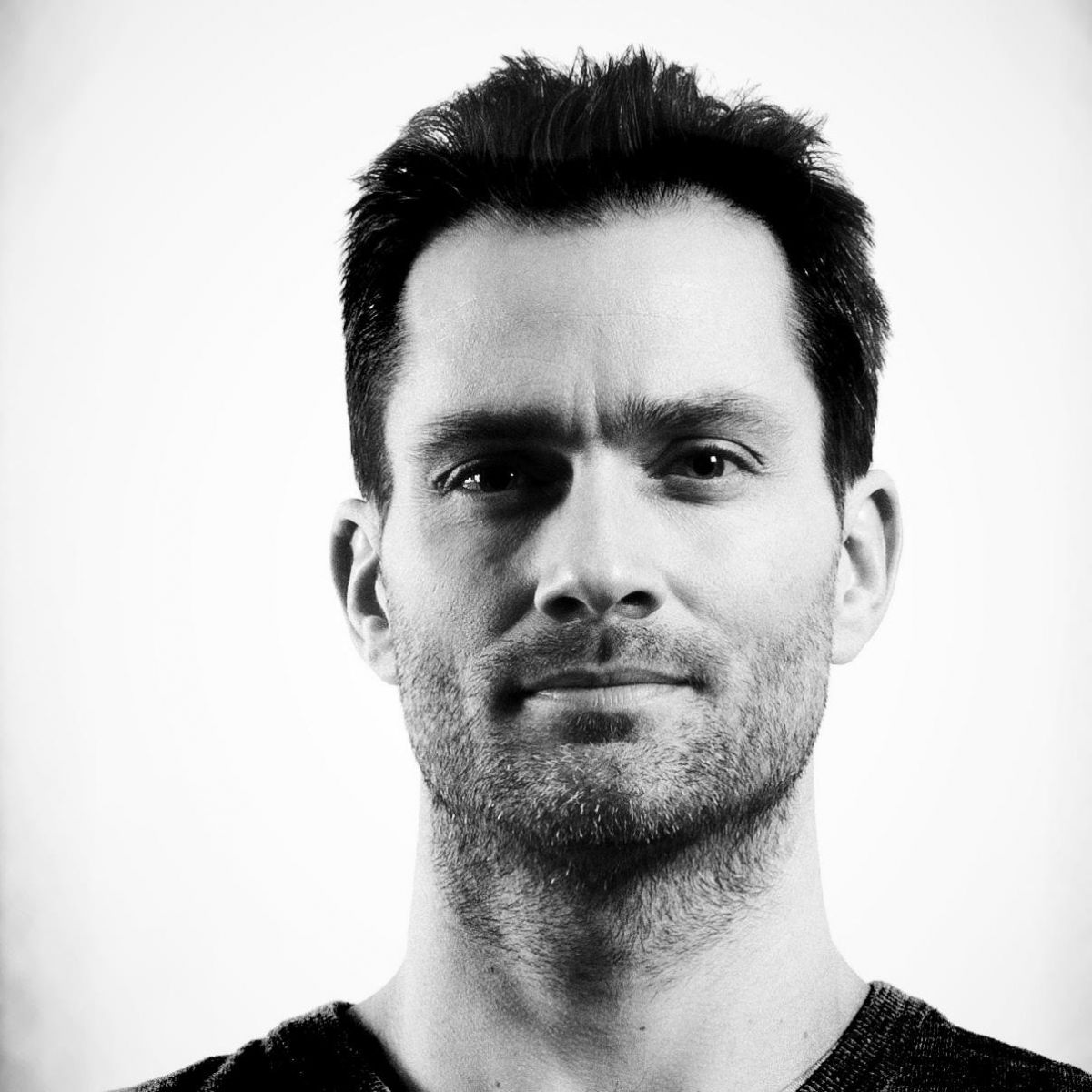 Scott Eaton is an artist, designer and photographer whose work combines traditional sculpting techniques with the power of modern digital tools such as Computer Graphics. He studied drawing and sculpture in Florence and received his Design and Computer Graphics education at the MIT Media Lab. Scott’s work often draws on classical themes and ideas: his ‘mythological’ sculptures include Prometheus, Hephaestus, Venus, Hercules and the Cyclops. In addition to his own projects, Scott frequently collaborates with other artists and studios, including artists Jeff Koons and Mark Wallinger, French crystal company Lalique (for Elton John), Nike, architect Asif Kahn for the Sochi Winter Olympics, and Academy Award winning visual effects studio Framestore. Scott also contributes his expertise to visual effects for film. Recent work includes World War Z, Spielberg’s War Horse, Wrath of the Titans, Harry Potter and the Deathly Hallows, Captain America, and Clash of the Titans.
Scott Eaton is an artist, designer and photographer whose work combines traditional sculpting techniques with the power of modern digital tools such as Computer Graphics. He studied drawing and sculpture in Florence and received his Design and Computer Graphics education at the MIT Media Lab. Scott’s work often draws on classical themes and ideas: his ‘mythological’ sculptures include Prometheus, Hephaestus, Venus, Hercules and the Cyclops. In addition to his own projects, Scott frequently collaborates with other artists and studios, including artists Jeff Koons and Mark Wallinger, French crystal company Lalique (for Elton John), Nike, architect Asif Kahn for the Sochi Winter Olympics, and Academy Award winning visual effects studio Framestore. Scott also contributes his expertise to visual effects for film. Recent work includes World War Z, Spielberg’s War Horse, Wrath of the Titans, Harry Potter and the Deathly Hallows, Captain America, and Clash of the Titans.
This interview with Jessica Hughes was recorded in Somerset House, London on 16th June 2016.
JH. Thanks very much for agreeing to this interview, Scott. May I begin by asking you about the mixture of ancient and modern in your artwork? You use these incredibly high-tech digital tools, and in many ways your work is very futuristic, but it’s also full of references to antiquity. Why return to the classical – what does it offer you?
SE. That’s a good question. Since I was young, my taste has always been Western art and Western sculpture. That was what I was exposed to first, and it was always my goal to be able to represent in that way. And so some of the themes probably also rubbed off on me, at least as inspiration. And then the other thing about it is that all the references are very well known. So people get the allusions. Even if you take an ancient theme and you reinterpret it, maybe remix it with a little bit of contemporary perspective, the fact that it’s grounded in something that people are a little bit familiar with gives them a kind of insight into what the piece is saying, or what it’s about. So that’s kind of how I approach it – as an entry point into a theme or subject matter. And then maybe remix it from there.
JH. Right. And so that applies very much to you using the names of mythological characters and ancient stories that people know. But also from a technical point of view, I noticed that you teach classes on artist’s anatomy, using sculptural fragments and life drawing. You’re quite traditional in some ways, aren’t you?
SE. Very traditional. My vocabulary and my tools are firmly grounded in traditional techniques. When I say ‘traditional’, I’m talking about eighteenth, maybe nineteenth-century techniques, which of course reference Renaissance stuff, which references Classical stuff. So it’s all like a chain of reinterpretation. The ancient Greeks were the first to really try to represent form properly – through a stylised filter, I mean. Every age has its own stylised filter. The Classical Greeks had their archetype of the human body, and the Romans copied it and then it was lost, and the Renaissance tried to recapture it, and then in the French Academy in the eighteenth, nineteenth centuries, they really hit this pinnacle of naturalism in representation. And fundamental to that – to all that lineage – was understanding anatomy, sculpting from life, studying predecessors. And that’s my background.
It’s one of those things where you learn the rules in order to break them. I teach all these things so that people…essentially have a tool. If they learn anatomy, they learn about figure sculpture, then they can bend or break the rules. Like Egon Schiele – he was this amazing, very powerful Expressionist artist from Vienna, and he was educated in all those things at the Academy before he dropped out, right? That’s the thing – all the people who made a fundamental difference in art at that time had the foundation. They chose not to use it, but it influenced their output in a certain way. Picasso was very similar. You have all these people who made a revolutionary step forward in representation, or abstraction of representation – so they learned representation and then abstracted it, but they know what they were abstracting! And then a few generations of artists have just ‘abstracted off other people’s abstractions’. And so it lost the fundamental foundation that the original guys have. Like Brancusi. Brancusi is a brilliant sculptor, but he studied with Rodin in that same academic tradition, and then rejected it. It’s like scales on the piano, you know? There are things that you know you have to be dextrous in, in your composition, or have the dexterity to play whatever you want.
JH. And then you can do your jazz improvisation…
SE. Yes exactly, like improvisation.
JH. I know you studied drawing in Florence – did you study sculpture there too?
SE. I did both, sculpture and drawing. The focus was on drawing, but it was almost half and half.
JH. And your Computer Graphics expertise – was that something you picked up at the same time?
SE. So, the long story is that I’ve always done Arts, but since I was a kid I was good at Math and Science too. And I enjoyed it. So actually in university I studied Mechanical Engineering and did Art classes on the side. And in my Engineering courses I was exposed to Computer Graphics. At the time it was very much a programming environment, but I was really fascinated by it. Being technically-minded, I could see in the far future a potential, even though the tools weren’t there yet. So I kept watching it, and then I ended up at MIT, and by then Computer Graphics had advanced quite a bit, so I was doing design in 3D and using these tools. And at the same time I was sculpting on the side, and drawing. But that whole time, I guess if I’d had to say which was my job, it was being more of an engineer than an artist. But at some point I began to flip that, and that’s when I went to Florence, and decided to dedicate a chunk of time to the artistic side.
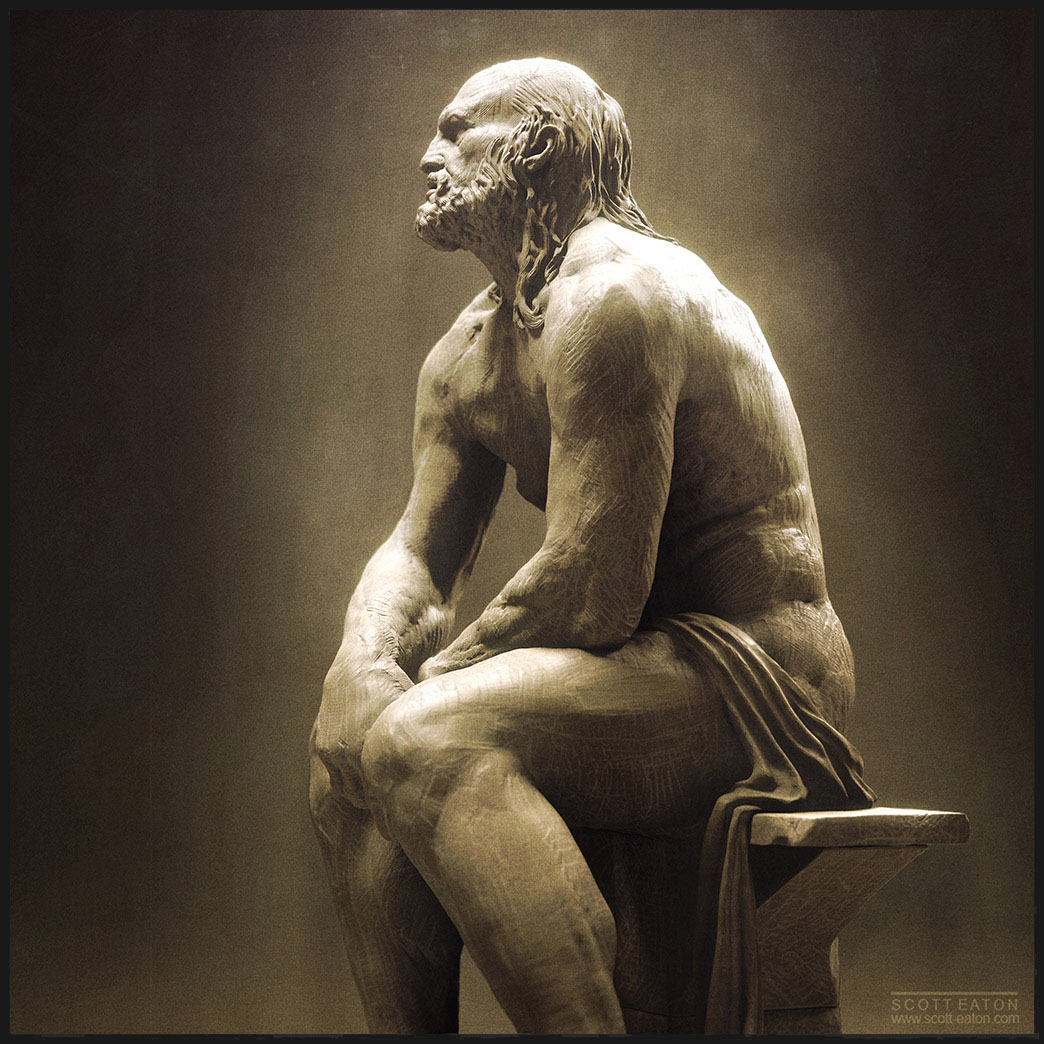
Hephaestus II, 2010 © Copyright Scott Eaton
JH. How long were you in Florence for?
SE. Sixteen months or so, not that long. I’d been before, but it’s just an inspiring place for someone who’s interested in that particular time period.
JH. Oh, it’s amazing. So, as you were learning these drawing and sculpting techniques, were you at the same time experimenting with doing similar things in Computer Graphics?
SE. A little bit. This was probably around 2002, so the tools were still developing, and I didn’t have a lot of resources there. I just had my laptop. There’s a limited amount of stuff you can do without computation. So I would play, but not seriously.
JH. That idea of you, back then, starting to blend your traditional sculptural practice with Computer Graphics is really intriguing to me. Even on the practical level…on the one hand, working marble is a subtractive process, right? But I guess with Computer Graphics you can add things on and shape them continuously until you are happy with them?
SE. Yes it’s like clay – digital clay. Clay can be an additive or a subtractive process. In a lot of ways there are huge technical advantages to doing things digitally. But at the same time, there’s something that’s missing – or you’re sacrificing something because there’s no tangible medium.
JH. Yes, that’s another area that I did want talk about. On the one hand, the absolute…boundary-breaking ways that you can transcend space and time with Computer Graphics – changing backgrounds, altering lighting and so forth. But at the same time, the sensory aspect is lost, or at least fundamentally altered. So sound, touch…
SE. Yeah, absolutely. All of those things. So you lose all your senses, and you lose a dimension, right? A visual, perceptual dimension. Because you are nominally sculpting looking at a 2D monitor.
JH. Even if you can rotate the object on the screen?
SE. You can rotate it, but there’s no depth of perception. I guess it’s probably the experience that people get when they walk around with an eye patch. You can see things, but they’re flat because you have no stereoscopic vision, and it’s okay if you move your head from left to right – your brain works out that something is roundish, or has depth – but you do miss that other dimension. I’m experiencing this acutely right now because I’m playing with my Virtual Reality headset. At my studio I’ve got this whole set-up, so I take my models, my sculptures, whatever I’m working on, and I work them out in the computer. And then I’ll put them into VR headsets, and just preview it in real three dimensions before I fabricate it. So I can scale it, make it tiny, look at it like it’s a miniature, make it normal size, like twenty centimetres, or I can make it three metres tall, or I can make it twenty metres tall.
JH. Can you tell me a bit more about how you then fabricate it? Is it with 3D printing?
SE. It depends on the size. 3D printing is of course the thing you do most of the time. Up to a certain scale, up to maybe 50cm. Then it becomes cost-prohibitive. It would be way too expensive to make it any bigger. It’s the volume, and the time. So when you go big, it generally becomes a subtractive process. You can do it a few ways. For something fully in-the-round, you’re probably talking about a seven-access robotic arm, with kind of a drill head that machines out in three dimensions from a block of high-density foam. And in some cases they just do it straight in marble.
JH. That reminds me – I told a few of my colleagues that I was meeting you, and they all said I should ask you about the Palmyra Arch [the 3D replica installed in London’s Trafalgar Square in April 2016].
SE. Yes, that’s exactly the same process. So that would have been done on a CNC machine using digital data. So as soon as you have digital data, whether it’s from a scan, or from a sculpture you’ve done yourself, then the output can be realised in any of the mediums – 3D printing, which has a number of different processes, or machining, or milling…. They milled it, the Palmyra Arch. The difference in the process is that they acquired that data from a bunch of photographs. There are some algorithms now that are sophisticated enough that if you have a bunch of photographs that show the same thing (and it doesn’t move) then it can work out where all those points were in space and construct a 3D model from it.
JH. The Palmyra Arch obviously raised some timely issues about the potential of Computer Graphics and digital art to recreate monuments, and to preserve or conserve them. But what about the issue of decay and fragility in relation to your own works? Do you have to think about the archiving and conserving of your sculptures? Or are they essentially everlasting?
SE. Decay is part of the process, I guess. If you make something in bronze, you want to see it age. If it’s marble and it’s outside, you want to see it weather. That’s part of the beauty of things in the real world. The digital data won’t decay – the thing in the computer won’t decay. As long as it’s preserved on some medium that can be read by the computer, it will be there, the exact same thing forever!
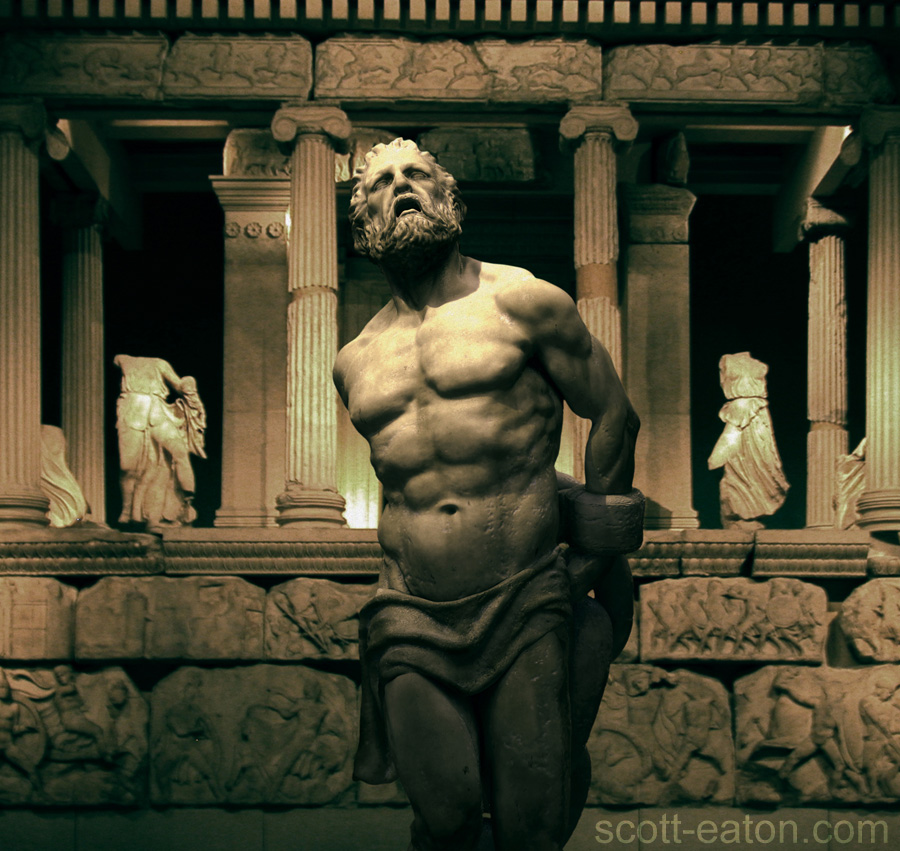
Prometheus © Copyright Scott Eaton.
JH. I remember you mentioning in a lecture that your Prometheus sculpture was deliberately ‘antiquated’ as part of the design, is that right?
SE. In that case, yes. That was one of my earliest pieces, and that was a bit of an experiment as well. So this medium they were all created in, Computer Graphics, is still new. The whole process is still in development. So Prometheus was about the form. It was a form study, a remix of this classical thing, but also just trying some new techniques in Computer Graphics. A lot of it was texturing techniques, rendering techniques. At the time there wasn’t 3D printing that was capable of… so you would sculpt things quite meticulously in the computer, just to create images. It’s a little bit of a conundrum, in that it’s quite a ‘faux’ thing to do, right? That whole notion of ‘honesty of the medium’ doesn’t really exist in CG, because the medium is…nothing, right? The medium is binary bits.
It is something I think about. What is truth to medium, if you’re a digital sculptor? And if you’re a digital sculptor who fabricates something and you 3D print it, the 3D printer prints out stereolithography, so you’ll see little lines, little ‘strata’ through the print from top to bottom as it stacks them. Should you polish it, or should you not? You can rub down all those lines so you can’t see them, but those are artefacts of the process, so should you leave them? Or say you have to make up a piece that’s comprised of twenty little blocks which you then combine them to make the whole thing – do you leave all those fusion lines? In my mind, I think the answer is ‘It depends’. It depends on the intention and the project. You can probably see that I don’t have a firm answer to that question!
JH. In antiquity you get these stories of artists like Zeuxis who want to create a painting that people think is real, or a sculpture that people look at and think ‘Oh, that’s a real animal’ without realising it’s a work of art. Those stories spring to mind now because they involve that same question of the boundary between art and life, or the boundaries between different types of art. I think that today more than ever, people often don’t know what they are looking at. Actually, when I first saw your Hephaestus II I instantly assumed it was a sepia photograph of a real marble sculpture.
SE. Yeah, I think that’s true. We’re so good at representation now. I worked in visual effects for a number of years, working on films and Hollywood movies. We are very good at making things look real. That illusion of life is something we’ve achieved. And we’re inundated with imagery all the time. Some of it’s real, some of it’s Photoshopped so it has fake 3D elements in it. I guess the most fundamental thing about an image – whether it’s a painting or a photograph or a composite – is the response that it elicits, the emotional response from the viewer. And so where is the boundary of ‘Is it Art?’ You can see ten million photographs on Instagram, as quick as your eyes can see them. We’re so inundated with imagery. Whereas 200 years ago it wasn’t the same metric. A painter strived to paint something realistically. That was his craft. And now that’s not the objective. It’s about the meaning behind the image.
JH. In your work there’s still a lot of technique, craft and mastery involved, but you’re also reinventing something, making a mix of different cultural references. When you make something for a film, for instance, you’re having to confront this question of ‘What does a Greek God look like?’ or ‘What does a Cyclops look like?’ Where do your different influences tend to come from?
SE. So, it depends on the pieces. It depends if it’s a commission or if it’s one of my personal projects. So let’s start with…maybe Prometheus. I loved the Prometheus myth. I love mythology. As humans, almost all of our stories are mythology of some description. Greek mythology has a huge richness to it, because there’s so much folly, so much…it’s just really fun! And I think the modern version is all the superhero mythology, all the comic book stuff. So Prometheus was just me appreciating the myth, and twisting it around. I’d seen a lot of Prometheus references, and my little ‘touch’ is those huge ankle-chains. I did a lot of studies in my sketch book too, to make something that was compelling.
JH. But it wasn’t based on any particular classical statue?
SE. No no, not at all, it’s totally my invention. It’s just a remix of the mythology. And then the other extreme is something like Venus or Hercules – my little iPad docking stations, which are a totally tongue-in-cheek poke at technology, and the state of society. We have these Apple-like, super-sleek lines, super-crisp design, and then we have obesity everywhere…. All these things in my mind are influencing the expression in some way.
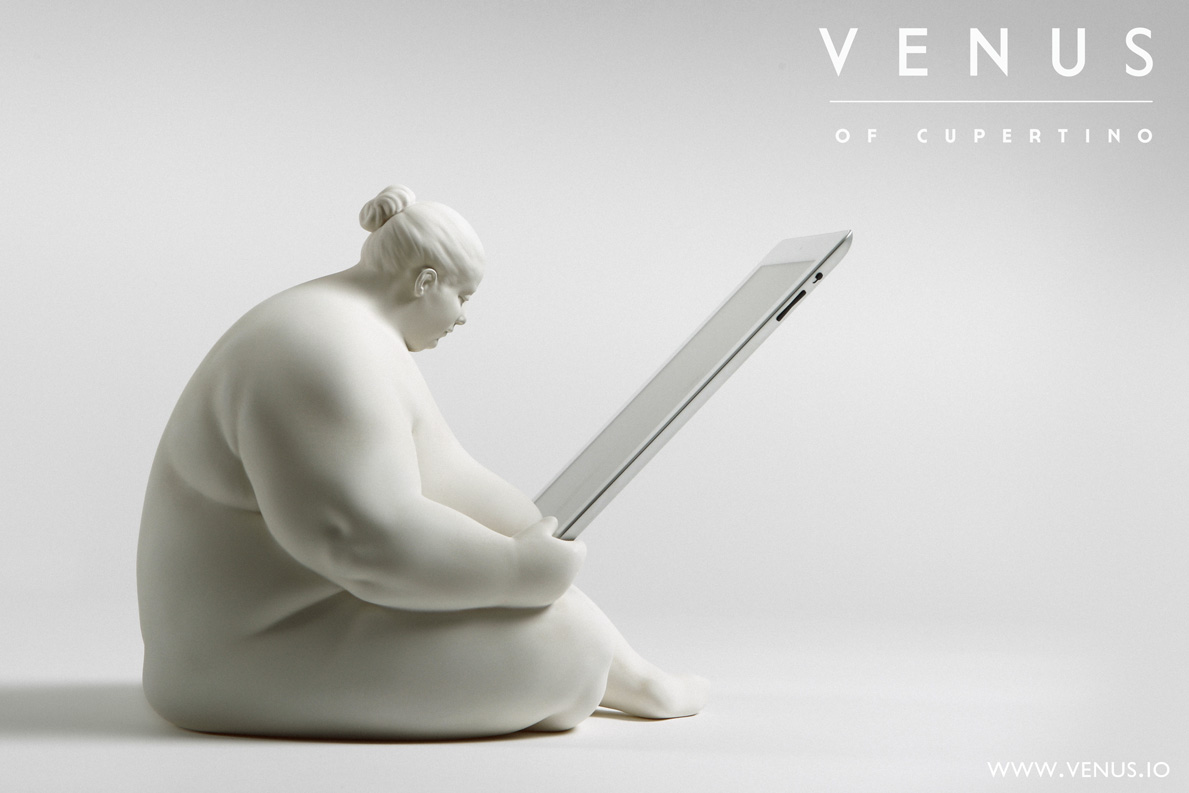
Venus of Cupertino iPad docking station © Copyright Scott Eaton.
JH. Those docking stations have been hugely popular, haven’t they?
SE. Yeah, Venus was very Zeitgeist, very 2013, she got a lot of love! She’s very ‘viral’, and she was all over for a while.
JH. Whereas going back to your Hephaestus II – when I saw that I immediately thought of that Hellenistic sculpture of the Weary Boxer.
SE. Yes, which I saw at the Getty just this last summer. They had a big Hellenistic exhibition. In fact, Hephaestus II wasn’t based on the Boxer. It’s independent confirmation of the same pose, or a similar pose, but it was just more of an emotional study of somebody in repose – a powerful figure in repose. That one was all about the lighting, the quality of the surface. This was a few years ago, so he was never a prototype, or fabricated – he was never made into a real sculpture. He’s still a bunch of bytes and kilobytes and megabytes on a computer somewhere.
JH. So what different sorts of creative process are involved when you make something for a film?
SE. That’s part of the visual effects process. My job was to sculpt the character and create the expressions, create the musculature and the anatomy. And then a team of people would put the puppet controls on it, somebody else would animate it, somebody would take care of the skin texture and skin colour, somebody would look at how that reacted to lights, and then somebody else would take care of how it was lit in the place the director photographed. So it’s a huge collaborative effort to make something that’s inherently initially sculptural turn into something that passes for ‘alive’.
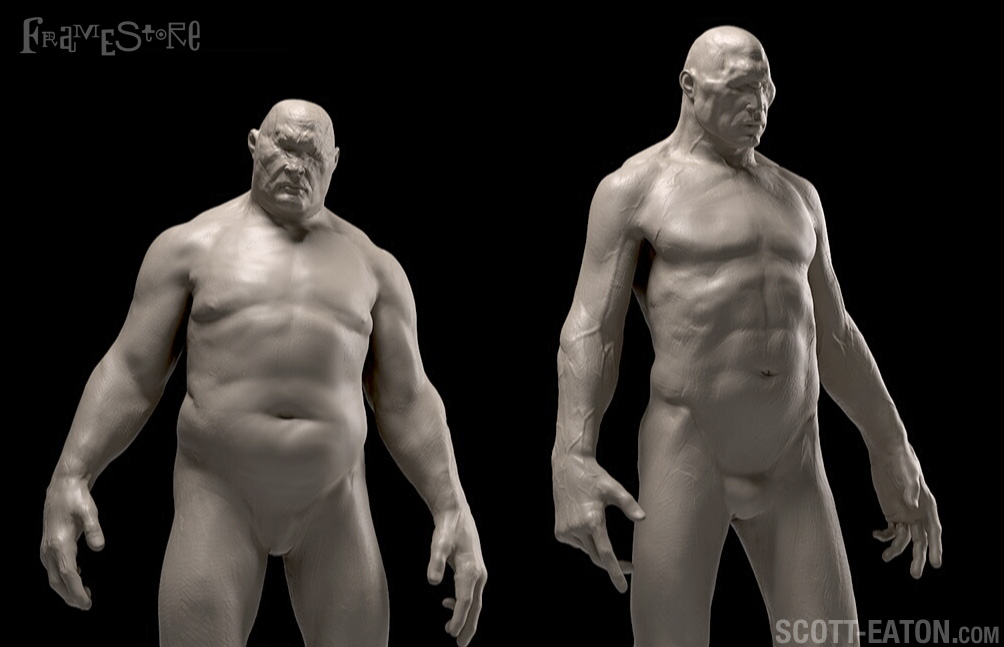
Digital studies for a Cyclops for the film 'Wrath of the Titans' © Copyright 2012 Warner Bros. Entertainment Inc.
JH. But essentially it was you who got to say ‘Hey, this is what a Cyclops is going to look like in 2012’!
SE. Yes, and I enjoyed that. That’s creativity, where you get to make something that doesn’t exist before. Okay, with a lot of references and allusions and influence from the director, the film…. In that kind of collaborative environment, certain key people have an influence on the direction. But primarily it’s my direction, because I feel strongly, generally, that things are right when I make them! But yes, it is created for the purpose of being in a film, so there’s a certain point when it leaves my control, and other people do what they need to do with it.
JH. Film is such an important medium now, isn't it, in terms of people getting to know classical stories and mythological references?
SE. Yes, all the mythology. Again, it’s popular because it’s familiar. There are a lot of narratives that are easily told and understood, and are rich with strife and humour and tragedy and all sorts. As Joseph Campbell said [in The Hero with a Thousand Faces], these myths are all archetypes of the same story, which is the hero’s adventure. We’ve retold the same stories for three thousand years, even back to Babylonian or Indian creation stories.
JH. Speaking of collaborative working and the retelling of stories, I know you’ve worked with people like Jeff Koons and Mark Wallinger, who have also drawn on these classical references, stories like the Minotaur, Venus, Diana, that kind of thing. Do you think that classical myth is having a particularly fertile ‘moment’ in twentieth, twenty-first century art?
SE. I don’t think it ever went away. It always simmers as an influence in Western Art. You can’t really escape it. Any trip to a museum, whether or not you’re paying attention, you’ll see a Rubens' Samson, a Bernini Neptune…. It’s always there at some level in popular cultural, or history, or art history. So if you’re an artist raised in the West, you’ll know about it. So if it eventually pops up in one of your pieces, it’s probably not surprising.
JH. So, your work crosses these boundaries between ‘conventional’ art and computation. That makes me really curious to find out how your work is received by different audiences. Have you had any resistance from other contemporary artists? And what do the Computer Graphics crowd think about the classical myths you present them with?
SE. The CG people are an interesting crowd, because more than anything they are caught by technique, and the technical achievements of things. If you divided the two crowds, you’d have the contemporary fine artists where the concept is paramount, then the digital artists and people who work with CG for whom technique and craftsmanship are paramount. I guess I’m halfway in between, because I can appreciate both, and I have been influenced by both, and I want to put craftsmanship in my own work, and I have the background in CG to realise that. And then, at the other end, I want to make artistic pieces with good concepts and some depth and some layers.
JH. Thank you very much, Scott – this has been an absolutely fascinating insight into your work.
Find out more....
- You can see more of Scott's work on his website: www.scott-eaton.com
- Watch a lecture about Dynamic Figure Sculpture given by Scott at the ZBrush Summit 2015.
- Listen to Scott's 2006 Tate Modern lecture Building a Greek God: The Techniques of Greek Sculpture.